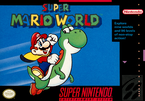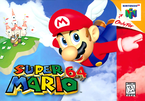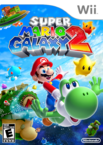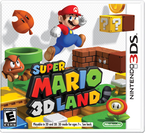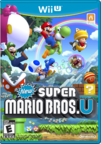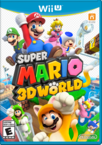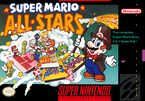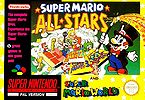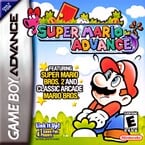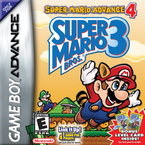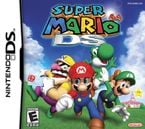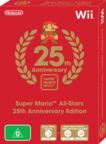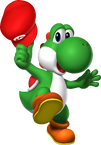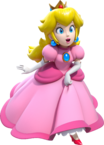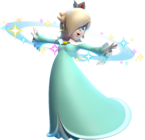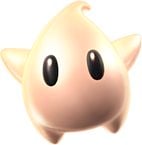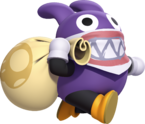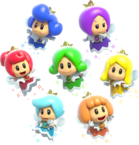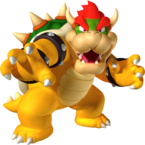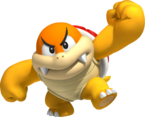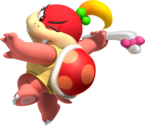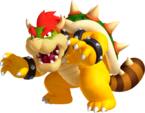Super Mario (series): Difference between revisions
No edit summary |
|||
| Line 1: | Line 1: | ||
{{articleabout|the main series of Mario platform games|the series as a whole, see |[[Mario (series)|here]]}} | |||
{{articleabout|the main series of Mario platform games|the series as a whole, | |||
{{series-infobox | {{series-infobox | ||
|title=Super Mario | |title=Super Mario | ||
| Line 256: | Line 255: | ||
|{{Releasedate|USA|2013}} [[Wii U]] | |{{Releasedate|USA|2013}} [[Wii U]] | ||
|- | |- | ||
|} | |||
==Characters== | |||
===Main protagonists=== | |||
{| align=center width=100% border=1 | |||
|- style="background-color: whitesmoke;" | |||
!width=10%|Character | |||
!width=65%|Brief Biography | |||
!width=15%|First ''Super Mario'' Appearance | |||
|- | |||
!Mario | |||
---- | |||
[[File:Mario_Artwork_(alt_2)_-_Super_Mario_3D_World.png|145x145px]] | |||
|[[Mario]] is the main hero of the series. He is often seen saving [[Princess Peach]] from the clutches of [[Bowser]]. He can become a variety of different forms including [[Small Mario]], [[Super Mario]], [[Fire Mario]], [[Raccoon Mario]], [[Tanooki Mario]], [[Cape Mario]], [[Wing Mario]], [[Mini Mario]], [[Mega Mario]], [[Gold Mario]], [[Cat Mario]], and more! Mario's trademark move is his jump. With his jump, he can jump on enemies. In games like ''[[Super Mario Bros. 2]]'' and ''[[Super Mario 3D World]]'', Mario has all-around controls. He will have to team up with [[Luigi]] and [[Yoshi]] to save the day time after time again. He appeared in every '''''Super Mario''''' game. | |||
|<center>''[[Super Mario Bros.]]''</center> | |||
|- | |||
!Luigi | |||
---- | |||
[[File:Luigi_Artwork_(alt)_-_Super_Mario_3D_World.png|145x145px]] | |||
|Face it, [[Luigi]] is "player two" most of the time and even started out as a palette swap, but there is more to [[Luigi]] than that. He can do his [[Scuttle]] jump in ''[[Super Mario Bros. 2]]'', ''[[Super Mario 64 DS]]'', ''[[New Super Luigi U]]'', and ''[[Super Mario 3D World]]'', as well as others. Starting in ''[[Super Mario Bros.: The Lost Levels]]'', Luigi had a higher jump and lower traction. This was later seen in several games. Luigi is player two because in 5 games, he could only be used as the second player. He hasn't appeared in every game like ''Super Mario 64'' and ''Super Mario Sunshine''. 2013 was his year and ''New Super Luigi U'' was released to accommodate it. | |||
|<center>''[[Super Mario Bros.]]'' | |||
|- | |||
!Yoshi | |||
---- | |||
[[File:Yoshi_Mario_Hat_SM64DS.png|145x145px]] | |||
|Yoshi is Mario's adorable little dinosaur. He first appeared in ''[[Super Mario World]]'' where Mario could find him in several levels. In ''[[New Super Mario Bros. Wii]]'', ''[[Super Mario Galaxy 2]]'', ''[[New Super Mario Bros U]]'', and [[New Super Luigi U|its DLC]], he fulfills the same role. He becomes the main star in ''[[Super Mario 64 DS]]'' where he had to rescue Mario from the [[Goomboss]]. His distinguishing feature is his tongue which he can eat enemies with. He can [[Flutter Jump]] and reach greater heights. He has appeared in most games and will hopefully appear in the future. | |||
|<center>''[[Super Mario World]]''</center> | |||
|- | |||
!Yellow Toad | |||
---- | |||
[[File:Yellow_Toad_NSMBW.png|145x145px]] | |||
|Yellow Toad first appears in ''[[New Super Mario Bros. Wii]]'' where he, along with Mario, Luigi, and Blue Toad go off to save Princess Peach from Bowser. He fulfills the same role in ''[[New Super Mario Bros. U]]'' where he has to help get Peach out of hostage from Bowser. He lastly appears in ''[[New Super Luigi U]]'' where he can do the scuttle jump. | |||
|<center>''[[New Super Mario Bros. Wii]]''</center> | |||
|- | |||
!Blue Toad | |||
---- | |||
[[File:Bluetoad2.png|145x145px]] | |||
|Blue Toad first appears in ''[[New Super Mario Bros. Wii]]'' where he, along with Mario, Luigi, and Yellow Toad go off to save Princess Peach from Bowser. He fulfills the same role in ''[[New Super Mario Bros. U]]'' where he has to help get Peach out of hostage from Bowser. He lastly appears in ''[[New Super Luigi U]]'' where he can do the scuttle jump. | |||
|<center>''[[New Super Mario Bros. Wii]]''</center> | |||
|} | |||
===Secondary protagonists=== | |||
{| align=center width=100% border=1 | |||
|- style="background-color: whitesmoke;" | |||
!width=10%|Character | |||
!width=65%|Brief Biography | |||
!width=15%|First ''Super Mario'' Appearance | |||
|- | |||
!Princess Peach | |||
---- | |||
[[File:Princess_Peach_Artwork_-_Super_Mario_3D_World.png|145x145px]] | |||
|[[Princess Peach]] is the damsel-in-distress in the series, in every game except ''[[Super Mario Bros. 2]]'' and ''[[Super Mario 3D World]]''. In those games, Peach is the slowest, but can hover in the air for several seconds. But most of the time saving Peach from the clutches of [[Bowser]] is the main goal. Sometimes she is kidnapped in incredible ways, such as getting a giant birthday cake thrown on her, or having her castle being probed into space by a giant UFO. She lives in [[Princess Peach's Castle|her castle]]. Whenever she is saved, Mario or Luigi will receive a kiss. Peach appeared in every '''''Super Mario''''' game. | |||
|<center>''[[Super Mario Bros.]]''</center> | |||
|- | |||
!Toad | |||
---- | |||
[[File:Toad_Artwork_-_Super_Mario_3D_Land.png|145x145px]] | |||
|[[Toad]] first was held in the first 7 castles of the original ''[[Super Mario Bros.]]''. Then in ''[[Super Mario Bros. 3]]'', ''[[New Super Mario Bros.]]'' games, and ''[[Super Mario 3D Land]]'', he hosts [[Toad Houses]], which have power-ups and 1UPs. In ''[[Super Mario Bros. 2]]'' and ''[[Super Mario 3D World]]'', he can run fast, but has a low jump. In these games, he has a blue cap. He does not appear in every '''''Super Mario''''' game, as he is absent in ''[[Super Mario World]]''. | |||
|<center>''[[Super Mario Bros.]]''</center> | |||
|- | |||
!F.L.U.D.D. | |||
---- | |||
[[File:FLUDD.jpg|145x145px]] | |||
|The Flash Liquidizer Ultra Dousing Device was created by [[Professor E. Gadd]] who gave it to Mario. [[F.L.U.D.D.]] has 4 nozzles: Squirt, Hover, Rocket, and Turbo. He helped Mario clean up the [[Graffiti]] dripped by the [[Magic Paintbrush]] in ''[[Super Mario Sunshine]]''. He would later be referenced in ''Super Mario Galaxy''. | |||
|<center> ''[[Super Mario Sunshine]]''</center> | |||
|- | |||
!Rosalina | |||
---- | |||
[[File:Rosalina_Artwork_-_Super_Mario_3D_World.png|145x145px]] | |||
|[[Rosalina]] first appears in ''[[Super Mario Galaxy]]'' where she can be found on the [[Comet Observatory]]. She is a "mama" to [[Lumas]]. She later reappears on [[Starship Mario]] when the player has all 242 stars in ''[[Super Mario Galaxy 2]]''. In ''[[Super Mario 3D World]]'', she can use the [[Spin]] ability, but also runs the slowest. She is unlocked after beating [[Super Galaxy]], a level that s based on ''Super Mario Galaxy'' | |||
|<center>''[[Super Mario Galaxy]]''</center> | |||
|- | |||
!Luma | |||
---- | |||
[[File:SMG_Luma.jpg|145x145px]] | |||
|Young Master [[Luma]] is a young apricot colored Luma who appears during the events of ''[[Super Mario Galaxy]]''. When inside [[Mario's Cap]], he gives Mario the [[Spin]] ability. He thinks of Rosalina as "mama", and lives aboard the Comet Observatory. He later appears in ''[[Super Mario Galaxy 2]]'' with the same purpose, but now he lives aboard Starship Mario with [[Lubba]]. Rosalina, however appears on the ship when the player receives 242 [[Power Stars]]. | |||
|<center>''[[Super Mario Galaxy]]</center> | |||
|- | |||
!Nabbit | |||
---- | |||
[[File:NabbitNSMBU.png|145x145px]] | |||
|[[Nabbit]] first appeared in ''[[New Super Mario Bros. U]]'' where he stole Toad's items. The player then catches him and gets a [[P-Acorn]] every time. He became a protagonist in ''[[New Super Luigi U]]'', where he, along with Luigi, Yellow Toad, and Blue Toad save Peach from the clutches of Bowser. He cannot use any power-ups, but is invincible, although he just goes through enemies, instead of defeating them. He can also get extra lives for grabbing items. | |||
|<center>''[[New Super Mario Bros. U]]''</center> | |||
|- | |||
!Sprixie Princesses | |||
---- | |||
[[File:Fairy_Group_Artwork_-_Super_Mario_3D_World.png|145x145px]] | |||
|The 7 [[Sprixie Princesses]] were kidnapped by Bowser in ''[[Super Mario 3D World]]''. Each one were kidnapped in worlds 1 to Castle (7), and they all had to be saved by the 5 heroes. They are found in [[World 1 (Super Mario 3D World)|World 1]]- Green, [[World 2 (Super Mario 3D World)|World 2]]- Yellow, [[World 3 (Super Mario 3D World)|World 3]]- Blue, [[World 4 (Super Mario 3D World)|World 4]]- Orange, [[World 5 (Super Mario 3D World)|World 5]]- Purple, [[World 6 (Super Mario 3D World)|World 6]]- Cyan, [[World Castle]]- Red, [[World Bowser]]- All 7. When the player beats the game, all 7 princesses build a rocket to [[World Star (Super Mario 3D World)|World Star]]. | |||
|<center>''[[Super Mario 3D World]]''</center> | |||
|} | |||
===Secondary protagonists=== | |||
{| align=center width=100% border=1 | |||
|- style="background-color: whitesmoke;" | |||
!width=10%|Character | |||
!width=65%|Brief Biography | |||
!width=15%|First ''Super Mario'' Appearance | |||
|- | |||
!Bowser | |||
---- | |||
[[File:Nsmb2_bowser.png|145x145px]] | |||
|King [[Bowser]] Koopa is the main antagonist of the '''''Super Mario''''' series. He is often the final boss where he kidnaps Peach and Mario and Luigi have to rescue her. He originally spat fire and threw hammers on a bridge in 8-4 ''[[Super Mario Bros.]]'' and 8-4, 9-3, and D-4 in ''[[Super Mario Bros.: The Lost Levels]]''. Later on, he became more powerful by introducing the [[Ground Pound]] in ''[[Super Mario Bros. 3]]'', Attacking in the [[Koopa Clown Car]] in ''[[Super Mario World]]'', rolling in a [[Spike Ball]] in ''[[Super Mario Galaxy]]'', and turning giant in several games. In ''[[Super Mario 3D World]]'', Bowser kidnaps the Sprixie Princesses. He has not appeared in every '''''Super Mario''''' game, because he is absent in ''[[Super Mario Bros. 2]]'' | |||
|<center>''[[Super Mario Bros]]''</center> | |||
|- | |||
!Bowser Jr. | |||
---- | |||
[[File:SMG_BowserJr.png|145x145px]] | |||
|Prince [[Bowser Jr.|Bowser Koopa Junior]] is Bowser's son and the heir to his father's throne as king of the [[Koopas]]. He first appeared in ''[[Super Mario Sunshine]]'', he wields the [[Magic Paintbrush]] used to create [[Graffiti]]. He has a mask to become [[Shadow Mario]]. He later appears in ''New Super Mario Bros.'' games, he is a miniboss fought at the end of [[Tower|Towers]] and [[Airships]]. He has his own Koopa Clown Car. In ''[[Super Mario Galaxy]]'' and ''[[Super Mario Galaxy 2]]'', he has an airship and several robots like [[Megaleg]], [[Megahammer]], and the [[Boomsday Machine]]. | |||
|<center>''[[Super Mario Sunshine]]''</center> | |||
|- | |||
!Koopalings | |||
---- | |||
[[File:Koopalings_-_New_Super_Mario_Bros_U.png|145x145px]] | |||
|The [[Koopalings]] are Bowser's adopted children. They often have [[Magic Scepter|Magic Scepters]] which they use to transform the [[Mushroom Kings]] into various creatures. There are 7 Koopalings: [[Larry Koopa|Larry]], [[Morton Koopa Jr.|Morton Jr.]], [[Wendy O. Koopa|Wendy O.]], [[Iggy Koopa|Iggy]], [[Roy Koopa|Roy]], [[Lemmy Koopa|Lemmy]], and [[Ludwig von Koopa|Ludwig]]. They kidnapped Peach in ''[[New Super Mario Bros. Wii]]'', and ''[[New Super Mario Bros. 2]]''. | |||
|<center>''[[Super Mario Bros. 3]]</center> | |||
|- | |||
!Boom Boom | |||
---- | |||
[[File:BoomBoomSM3DL.png|145x145px]] | |||
|[[Boom Boom]] first appears in ''[[Super Mario Bros. 3]]'' where was the boss in [[Fortress|Fortresses]] and tanks. He would occasionally have wings. He fulfills the same role in ''[[New Super Mario Bros. U]]'' where he was the boss of the first 6 towers. In ''[[Super Mario 3D Land]]'' and ''[[Super Mario 3D World]]'', he resides in airships (Land) and tanks (World). He has a retractable green spiked shell in ''Super Mario Bros. 3'', a non-retractable red spiked shell in ''New Super Mario Bros. U'', and a normal red shell in ''Super Mario 3D Land'' and ''World''. He has an ally named Pom Pom. | |||
|<center>''[[Super Mario Bros. 3]]''</center> | |||
|- | |||
!Pom Pom | |||
---- | |||
[[File:Pom_pom.png|145x145px]] | |||
|[[Pom Pom]] is a female, pink [[Boom Boom (species)|Boom Boom]] that wears green hair beads and had a smooth, polka-dotted shell. She is an ally of Boom Boom and is often seen fighting alongside him. In ''[[Super Mario 3D Land]]'', she throws boomerangs and attempts to crush the player with his shell while in ''[[Super Mario 3D World]]'', she throws shurikens and creates clones. The clones have grey, rather than the real one's pink shurikens, and no hair beads, making it easy to find the real one. She has been fought in airships ''(Land)'' and trains ''(World)''. | |||
|<center>''[[Super Mario 3D Land]]''</center> | |||
|- | |||
!False Bowser | |||
---- | |||
[[File:Tanooki_Bowser.png|145x145px]] | |||
|[[False Bowser|False Bowsers]] first appear in ''[[Super Mario Bros.]]'' where they guard the castles of Worlds 1-7. They are various species that can either be defeated by fireballs or lowering the bridge with an axe. They reappear in ''[[Super Mario Bros.:the Lost Levels]]'' with the same purpose, now they are found in Worlds 1-7, A-C. In ''[[Super Mario 3D Land]]'', they appear as Bowser but with Tanooki tails. They appear in the [[Castle|Castles]] of Worlds 1 and 5. | |||
|<center>''[[Super Mario Bros.]]''</center> | |||
|} | |} | ||
| Line 264: | Line 397: | ||
==References== | ==References== | ||
<references/> | <references/> | ||
<br clear=all> | <br clear=all> | ||
{{Mariogames}} | {{Mariogames}} | ||
[[Category:Super Mario Series|*]] | [[Category:Super Mario Series|*]] | ||
[[Category:Game Series]] | [[Category:Game Series]] | ||
Revision as of 22:59, December 28, 2013
Template:Articleabout Template:Series-infobox The Super Mario series, also called the main series or main games, is the biggest and most important sub-series of the Mario series. It started in 1985 with the creation of Super Mario Bros. on the Famicom and subsequently the Nintendo Entertainment System. It has been followed by many sequels released in almost every Nintendo video game console to date, except the Game Boy, the Game Boy Color and the Game Boy Advance, where only remakes, ports, or other spin-offs games where released.
Most of these games, notably excluding Super Mario Bros. 2, Super Mario World 2: Yoshi's Island[1] and the Super Mario Land series, follow the story of Mario and, usually, his brother Luigi and sometimes his best friend Yoshi, in their quest to search for and rescue Princess Peach from the clutches of Bowser, who wants to conquer the Mushroom Kingdom, or another location, depending on the game. The Mario brothers' adventure is not easy, however, as they must face Bowser's troops throughout, who attempt to thwart the brothers' attempts to rescue the princess.
All the games, and even some remakes, have been developed exclusively by the Nintendo Entertainment Analysis and Development (also known as Nintendo EAD) branch but not by the same sub-division.
In 2010, the series celebrated the twenty-fifth anniversary of the release of Super Mario Bros.. The celebration involved a series of videos showing various tricks throughout the series' games on the Wii's Nintendo Channel, as well as releasing a Wii port of Super Mario All-Stars, which included a history booklet of the Super Mario series and a CD containing several songs from games in the series.
Main games
It has been requested that this article be rewritten and expanded to include more information.
| Title, original release and system | Synopsis and Ratings |
|---|---|
| Super Mario Bros.
|
Super Mario Bros. is the first installment in the Super Mario series. It was first released for the Famicom and the NES in 1985. This game set the standard for the later games, and it was eventually re-released for many newer systems, including the Game Boy Advance and the Virtual Console for the Wii. This game marks the first appearance for many new protagonists, species, and villains. These characters include Bowser, Princess Peach (then known as Princess Toadstool), Toad and the Mushroom Retainers, Goombas, Koopa Troopas, and many more. |
| Template:Releasedate NES | (Ratings unavailable) |
| Super Mario Bros.: The Lost Levels
|
A year after the release of Super Mario Bros., Nintendo released Super Mario Bros.: The Lost Levels. It was released for the Famicom Disk System. It uses a slightly altered version of Super Mario Bros.'s engine, with different levels and new features including altered graphics and new enemy behavior. This game is known in Japan as Super Mario Bros. 2; Nintendo of America originally deemed this game too challenging and too much like the original to sell well in western countries. However, the game made its appearance in western countries as part of Super Mario All-Stars, and recently, this game was released for the Virtual Console on the Wii. |
| Template:Releasedate Famicom | (Ratings unavailable) |
| Super Mario Bros. 2
|
Super Mario Bros. 2 is the third game in the Super Mario series. It was released in 1988 for the Famicom and the NES. New species first appear in this game, including Albatoss and Shy Guys, and it introduces Wart and Birdo. Super Mario Bros. 2 is also the first game to feature four distinctly playable characters (Mario, Luigi, Toad, and Princess Peach). Super Mario Bros. 2 was based on the Japanese game Yume Kōjō: Doki Doki Panic. In Japan, this game is commonly called Super Mario USA. |
| Template:Releasedate NES | (Ratings unavailable) |
| Super Mario Bros. 3
|
Super Mario Bros. 3 is the fourth Super Mario game. It was released for the Famicom and the NES. Many new species appear, including now-staples like Boo and Spike. Boom Boom, Dry Bones, and the Koopalings also first appear here. New power-ups also appear such as the Super Leaf, the Hammer Suit and the Frog Suit. It has been considered as one of the greatest games of all time. Its complexity and challenging levels made it a huge success. In addition to new power ups, it featured new moves, items, and enemies. It also features special non-level parts of each world, including Toad Houses where lives are earned and Spade Panels, as well as some secret parts, such as the White Toad House and the Treasure Ship. |
| Template:Releasedate NES | (Ratings unavailable) |
| Super Mario World
|
Super Mario World was released in 1990 for the Super Famicom. It was also re-released as the second installment in the Super Mario Advance series. In this game Mario and Peach go on a trip to Dinosaur Land but things go awry when Bowser kidnaps Peach. This game was notable for inducing Yoshi and the species. It is the fifth installment in the Super Mario series. |
| Template:Releasedate SNES | (Ratings unavailable) |
| Super Mario 64
|
Super Mario 64 has its own unique gameplay and story to the Super Mario series. It was released in 1996 for the Nintendo 64. In this game, Mario uses Power Stars to retrieve the kidnapped Peach. Mario jumps into paintings trying to find Peach. Unlike prior games, the goal of the levels in Super Mario 64 is not to find the end of the stage; rather, Mario must find Power Stars by completing missions in each course. This is also the first 3D game in this series. Though it was not the first 3-D platforming game, it revolutionized the genre, with many games soon following its formula, using it as a sort of benchmark. It is widely acclaimed as one of the greatest games of all time. A remake for this game came out in 2004 for the Nintendo DS called Super Mario 64 DS. This game introduced new bosses, such as King Bob-omb and Eyerok. |
| Template:Releasedate Nintendo 64 | IGN - 9.8: Amazing• Gamespot - 9.4: Superb |
| Super Mario Sunshine
|
Super Mario Sunshine was released in 2002 for the Nintendo GameCube. Its gameplay is similar to Super Mario 64; however, it has a unique storyline. Mario, Princess Peach, and Toadsworth are taking a vacation to Isle Delfino, when they find that the island has been vandalized and the Shine Sprites stolen by a strange enemy that looks like Mario himself. Mario is then taken into custody and tasked with cleaning up the entire island. Instead of collecting Power Stars, the player collects Shine Sprites. This game also introduced many recurring characters and bosses in the Mario series, including Toadsworth, Bowser Jr., Petey Piranha, Gooper Blooper, Piantas, Nokis, Shadow Mario, and F.L.U.D.D.. Super Mario Galaxy is the respective follow-up to this game. This is the second 3D game in the series. |
| Template:Releasedate Nintendo GameCube | IGN - 9.4: Outstanding • Gamespot - 8.0: Great |
| New Super Mario Bros.
|
New Super Mario Bros. is the eighth installment in the Super Mario series. It starts out when Bowser Jr. kidnaps Peach during a strange accident. Luigi is playable in this game, too. Luigi was not playable since Super Mario World. This is the first game since Super Mario World (1990) that features the classic 2D play-style of the Super Mario Bros. games. The game features a solo story mode with Mario or Luigi, a two-player wireless game Mario vs. Luigi, as well as a mini-game mode for up to four players. It was released in 2006 for the Nintendo DS. It spiraled a sequel, New Super Mario Bros. Wii, though that game is not considered to be a direct sequel to the DS game. |
| Template:Releasedate Nintendo DS | IGN - 9.5: Incredible • Gamespot - 9.0: Superb |
| Super Mario Galaxy
|
Super Mario Galaxy is the ninth installment in the Super Mario series and the third 3D game in the series. However, unlike the previous two 3D installments for the Mario series, this game takes place in deep space. Mario attends the Star Festival at the request of Princess Peach, when the town comes under attack by Bowser's air forces. He abducts Peach's entire castle and warps it to the center of the universe, prompting Mario to save her. Most of the game's levels consist of many small planets and planetoids, while others have bigger planets. A new popular species and character appear, Luma and Rosalina. It was released in 2007 for the Wii. This game spiraled a direct sequel, simply called Super Mario Galaxy 2. It is currently the only 3D game that has done so. |
| Template:Releasedate Wii | IGN - 9.7: Outstanding • Gamespot - 9.5: Superb |
| New Super Mario Bros. Wii
|
New Super Mario Bros. Wii is the tenth installment in the Super Mario series and the second for the Wii. It is an indirect follow-up to New Super Mario Bros.. In this game, Yoshis are rideable and the Koopalings return. In addition to the single-player experience, the game also features a multiplayer mode for up to four players simultaneously. This is the first time simultaneous multiplayer is possible in a Super Mario game. Two new playable characters appear, Yellow Toad and Blue Toad. New power-ups also appear including the Propeller Suit and the Penguin Suit. |
| Template:Releasedate Wii | IGN - 8.9: Great • Gamespot - 8.5: Great |
| Super Mario Galaxy 2
|
Super Mario Galaxy 2 is the eleventh installment in the Super Mario series. It is also the fourth 3D game in the series. The sequel contains many elements from its predecessor, such as the story, the adventure being in outer space, recurring objects such as Launch Stars, recurring items including the Bee Mushroom, and the elements of gravity. However, the game introduces new elements such as the utilization of Yoshi and new power-ups such as the Cloud Flower. Rosalina reappears and new characters of the Luma species appear including Lubba. This is the third installment for the Wii in the Super Mario series. |
| Template:Releasedate Wii | IGN - 10.0: Masterful • Gamespot - 10.0: Prime |
| Super Mario 3D Land
|
Super Mario 3D Land is the fifth 3D game in the series, and the twelfth game overall. The levels of Super Mario 3D Land are much more linear and compact than the other 3D titles, more along the lines of the side-scrolling games. Many retro power-ups and characters return, such as False Bowsers, the Super Leaf and Boom Boom. New power-ups are also introduced, such as Boomerang Mario, and White Tanooki Mario. It also introduces new enemies and a female partner of Boom Boom named Pom Pom. |
| Template:Releasedate Nintendo 3DS | IGN - 9.5: Amazing • Gamespot - 8.0: Good |
| New Super Mario Bros. 2
|
New Super Mario Bros. 2 is another side-scroller in the series released in 2012 for the Nintendo 3DS. It's the third game in the New Super Mario Bros. line and a direct sequel to New Super Mario Bros.. The game features an extremely large amount of coins, which are one of the game's main elements. Raccoon Mario makes a return. A new Power-Up called Gold Flower appears and turn Mario into Gold Mario. |
| Template:Releasedate Nintendo 3DS | IGN - 8.5: Great • Gamespot - 7.0: Good |
| New Super Mario Bros. U
|
New Super Mario Bros. U is a side-scroller for the Wii U. The game seems to borrow some elements from Super Mario World such as Baby Yoshis, Sumo Bros., Bony Beetles, etc. and minor references like diagonal pipes making a return. The game plays very similar to New Super Mario Bros. Wii with its four-player mode, however a player with a Wii U GamePad can create platforms in what Nintendo refers to as "Boost Mode". It is the first Super Mario game (and Mario game overall) to be released in high-definition. The game also introduces a new form, Flying Squirrel Mario. |
| Template:Releasedate Wii U | IGN - 9.1: Amazing • Gamespot - 8.5: Great |
| Super Mario 3D World
|
Super Mario 3D World is the sequel to Super Mario 3D Land. The game features a new power-up called Cat Mario and the whole playable cast from Super Mario Bros. 2 is playable. The story follows Mario, Luigi, Princess Peach, Toad and Rosalina traveling through the Sprixie Kingdom to rescue the Sprixies Bowser has captured to steal their treasure. [2] |
| Template:Releasedate Wii U | - |
Ports, Remakes, and Downloadable Content
| Title, original release and system | Synopsis and Ratings |
|---|---|
| Super Mario Bros. (Game & Watch)
|
In 1987, a simplified take on the Super Mario Bros. formula was released for the Game & Watch. It is a sidescroller where Mario had to move over several platforms, avoiding Lakitus and Bullet Bills. |
| Template:Releasedate Game & Watch | (Ratings unavailable) |
| Super Mario All-Stars
|
Super Mario All-Stars also known as Super Mario Collection in Japan was released in 1993 also for the Super Nintendo Entertainment System. It is a remake of the first four Super Mario series games. Super Mario Bros., Super Mario Bros. 2 Super Mario Bros. 3, and Super Mario Bros.: The Lost Levels. This game updated the four games' graphics and sound to enhance them. However, it is not technically considered an installment because it is just a simple remake. |
| Template:Releasedate SNES | (Ratings unavailable) |
| Super Mario All-Stars + Super Mario World
|
Super Mario All-Stars + Super Mario World is an America/Europe-only remake of Super Mario All-Stars that also includes Super Mario World for the Super Nintendo Entertainment System. It is the second remake of the series. |
| Template:Releasedate SNES | (Ratings unavailable) |
| Super Mario Bros. Deluxe
|
Super Mario Bros. Deluxe is a Game Boy Color remake which includes the first two Super Mario games ever released: Super Mario Bros. and Super Mario Bros.: The Lost Levels (that last under the name of Super Mario Bros.: For Super Players). Besides those games, it also featured many other collectibles, including images that could be printed with the Game Boy Printer, Cable Link interface multi-player, records sharing by infrared connection, a calendar, a fortune teller, etc. Unlike other remakes, it wasn't developed by Nintendo EAD, but by Nintendo R&D2. |
| Template:Releasedate Game Boy Color | IGN - 10: Masterful • Gamespot - 9.9: Superb |
| Super Mario Advance
|
Super Mario Advance is a remake of Super Mario Bros. 2 made for the handheld game system, the Game Boy Advance, and released in 2001. Like the Super Mario All-Stars port, Super Mario Advance had updated graphics. |
| Template:Releasedate Game Boy Advance | IGN - 8.0: Great • Gamespot - 8.2: Great |
| Super Mario World: Super Mario Advance 2
|
Super Mario World: Super Mario Advance 2 is a remake of Super Mario World made for the Game Boy Advance. It was the second title in the Super Mario Advance series and was released in 2002. There are various differences between the original Super Mario World and Super Mario Advance 2. The game was a gigantic hit for Nintendo and the Game Boy Advance, selling 3,290,000 copies in the United States and 5,460,000 copies worldwide. Additionally, Luigi's sprite has been changed and made taller than Mario to match his normal appearance, and the Mario Bros. classic game has been included in the game (like the other Mario Advance games), with multiplayer playable. |
| Template:Releasedate Game Boy Advance | IGN - 9.3: Amazing • Gamespot - 9.4 |
| Super Mario Advance 4: Super Mario Bros. 3
|
In 2003, the fourth entry in the Super Mario Advance series, Super Mario Advance 4: Super Mario Bros. 3, was released for the Game Boy Advance. It boasted similar graphics and sound to the Super Mario All-Stars version, and made use of the e-Reader. A few e-cards came included with new copies of the game, while two sets (referred to as "series") of cards, were released and sold alongside the game. By scanning special cards into the e-Reader, players were able to upload items, videos, and most importantly, new levels into the game. One notable item was the Cape Feather from Super Mario World, which allowed Mario to transform into Cape Mario. There were also two Switch cards that the player could activate (and deactivate) the effects of by scanning them; the Orange Switch and the Blue Green Switch. Scanning these switches triggered small functions in the game. The e-Reader feature is still available in the European version, but it is disabled by default and unable to access. |
| Template:Releasedate Game Boy Advance | IGN - 9.5: Amazing • Gamespot - 8.9: Great |
| Classic NES Series: Super Mario Bros.
|
The original NES version of Super Mario Bros. was released for the Game Boy Advance as part of the Classic NES series of games in commemoration for the 20th anniversary of the release of the original Famicom and NES. It is a port, and doesn't feature any new additions, and all of the bugs were left in the game and only the graphics were down-scaled to fit the GBA screen resolution. |
| Template:Releasedate Game Boy Advance | (Ratings unavailable) |
| Famicom Mini: Super Mario Bros. 2
|
In Japan, the Classic NES Series were known as Famicom Mini. The original Super Mario Bros. 2 (known in western regions as Super Mario Bros.: The Lost Levels) was released only in Japan. Much like Super Mario Bros., it didn't feature any new additions, the bugs were left untouched, and the graphics were down-scaled. |
| Template:Releasedate Game Boy Advance | (Ratings unavailable) |
| Super Mario 64 DS
|
Super Mario 64 DS is a remake of Super Mario 64. It was released in 2004 for the Nintendo DS. It is also the first Mario game released for the Nintendo DS. Though it is a remake, there are many differences between it and the original. One difference is that there are many additional secret stars, making 150 Power Stars instead of the previous 120. Wario, Luigi, and Yoshi are also playable, and mini-games were added. |
| Template:Releasedate Nintendo DS | IGN - 8.9: Great • Gamespot - 8.4: Great |
| Super Mario All-Stars Limited Edition
|
Released for the Wii in 2010, Super Mario All-Stars Limited Edition celebrates the 25th anniversary of Mario featuring the same games as mentioned in the All-Stars section. It is a port of the original game Super Mario All-Stars. |
| Template:Releasedate Wii | IGN - 7.0: Good |
| New Super Luigi U
|
New Super Luigi U is a game released to celebrate the Year of Luigi. It retains many graphics and features, such as the story and world map, have been retained from New Super Mario Bros. U, as it has also been released as a DLC title for said game. However all of the levels have been changed, and this time, Mario is absent, making Luigi the main character. Nabbit has been made a playable character, taking Mario's place. The packaged version will be availible at retail until the end of the Year of Luigi (2013). |
| Template:Releasedate Wii U | IGN - 7.3: Good |
| New Super Mario Bros. U + New Super Luigi U File:Box NA - New Super Mario Bros. U + New Super Luigi U.png |
A compilation of both New Super Mario Bros. U and New Super Luigi U on the same disk, released exclusively with the Mario & Luigi Deluxe Wii U set (known as the Premium Pack in Europe). New Super Mario Bros. U + New Super Luigi U includes notable changes to the originals, including a new title screen and over 200 videos included as bonus content. |
| Template:Releasedate Wii U |
Characters
Main protagonists
| Character | Brief Biography | First Super Mario Appearance |
|---|---|---|
| Mario
|
Mario is the main hero of the series. He is often seen saving Princess Peach from the clutches of Bowser. He can become a variety of different forms including Small Mario, Super Mario, Fire Mario, Raccoon Mario, Tanooki Mario, Cape Mario, Wing Mario, Mini Mario, Mega Mario, Gold Mario, Cat Mario, and more! Mario's trademark move is his jump. With his jump, he can jump on enemies. In games like Super Mario Bros. 2 and Super Mario 3D World, Mario has all-around controls. He will have to team up with Luigi and Yoshi to save the day time after time again. He appeared in every Super Mario game. | |
| Luigi
|
Face it, Luigi is "player two" most of the time and even started out as a palette swap, but there is more to Luigi than that. He can do his Scuttle jump in Super Mario Bros. 2, Super Mario 64 DS, New Super Luigi U, and Super Mario 3D World, as well as others. Starting in Super Mario Bros.: The Lost Levels, Luigi had a higher jump and lower traction. This was later seen in several games. Luigi is player two because in 5 games, he could only be used as the second player. He hasn't appeared in every game like Super Mario 64 and Super Mario Sunshine. 2013 was his year and New Super Luigi U was released to accommodate it. | |
| Yoshi
|
Yoshi is Mario's adorable little dinosaur. He first appeared in Super Mario World where Mario could find him in several levels. In New Super Mario Bros. Wii, Super Mario Galaxy 2, New Super Mario Bros U, and its DLC, he fulfills the same role. He becomes the main star in Super Mario 64 DS where he had to rescue Mario from the Goomboss. His distinguishing feature is his tongue which he can eat enemies with. He can Flutter Jump and reach greater heights. He has appeared in most games and will hopefully appear in the future. | |
| Yellow Toad
|
Yellow Toad first appears in New Super Mario Bros. Wii where he, along with Mario, Luigi, and Blue Toad go off to save Princess Peach from Bowser. He fulfills the same role in New Super Mario Bros. U where he has to help get Peach out of hostage from Bowser. He lastly appears in New Super Luigi U where he can do the scuttle jump. | |
| Blue Toad
|
Blue Toad first appears in New Super Mario Bros. Wii where he, along with Mario, Luigi, and Yellow Toad go off to save Princess Peach from Bowser. He fulfills the same role in New Super Mario Bros. U where he has to help get Peach out of hostage from Bowser. He lastly appears in New Super Luigi U where he can do the scuttle jump. |
Secondary protagonists
| Character | Brief Biography | First Super Mario Appearance |
|---|---|---|
| Princess Peach
|
Princess Peach is the damsel-in-distress in the series, in every game except Super Mario Bros. 2 and Super Mario 3D World. In those games, Peach is the slowest, but can hover in the air for several seconds. But most of the time saving Peach from the clutches of Bowser is the main goal. Sometimes she is kidnapped in incredible ways, such as getting a giant birthday cake thrown on her, or having her castle being probed into space by a giant UFO. She lives in her castle. Whenever she is saved, Mario or Luigi will receive a kiss. Peach appeared in every Super Mario game. | |
| Toad
|
Toad first was held in the first 7 castles of the original Super Mario Bros.. Then in Super Mario Bros. 3, New Super Mario Bros. games, and Super Mario 3D Land, he hosts Toad Houses, which have power-ups and 1UPs. In Super Mario Bros. 2 and Super Mario 3D World, he can run fast, but has a low jump. In these games, he has a blue cap. He does not appear in every Super Mario game, as he is absent in Super Mario World. | |
| F.L.U.D.D.
|
The Flash Liquidizer Ultra Dousing Device was created by Professor E. Gadd who gave it to Mario. F.L.U.D.D. has 4 nozzles: Squirt, Hover, Rocket, and Turbo. He helped Mario clean up the Graffiti dripped by the Magic Paintbrush in Super Mario Sunshine. He would later be referenced in Super Mario Galaxy. | |
| Rosalina
|
Rosalina first appears in Super Mario Galaxy where she can be found on the Comet Observatory. She is a "mama" to Lumas. She later reappears on Starship Mario when the player has all 242 stars in Super Mario Galaxy 2. In Super Mario 3D World, she can use the Spin ability, but also runs the slowest. She is unlocked after beating Super Galaxy, a level that s based on Super Mario Galaxy | |
| Luma
|
Young Master Luma is a young apricot colored Luma who appears during the events of Super Mario Galaxy. When inside Mario's Cap, he gives Mario the Spin ability. He thinks of Rosalina as "mama", and lives aboard the Comet Observatory. He later appears in Super Mario Galaxy 2 with the same purpose, but now he lives aboard Starship Mario with Lubba. Rosalina, however appears on the ship when the player receives 242 Power Stars. | |
| Nabbit
|
Nabbit first appeared in New Super Mario Bros. U where he stole Toad's items. The player then catches him and gets a P-Acorn every time. He became a protagonist in New Super Luigi U, where he, along with Luigi, Yellow Toad, and Blue Toad save Peach from the clutches of Bowser. He cannot use any power-ups, but is invincible, although he just goes through enemies, instead of defeating them. He can also get extra lives for grabbing items. | |
| Sprixie Princesses
|
The 7 Sprixie Princesses were kidnapped by Bowser in Super Mario 3D World. Each one were kidnapped in worlds 1 to Castle (7), and they all had to be saved by the 5 heroes. They are found in World 1- Green, World 2- Yellow, World 3- Blue, World 4- Orange, World 5- Purple, World 6- Cyan, World Castle- Red, World Bowser- All 7. When the player beats the game, all 7 princesses build a rocket to World Star. |
Secondary protagonists
| Character | Brief Biography | First Super Mario Appearance |
|---|---|---|
| Bowser
|
King Bowser Koopa is the main antagonist of the Super Mario series. He is often the final boss where he kidnaps Peach and Mario and Luigi have to rescue her. He originally spat fire and threw hammers on a bridge in 8-4 Super Mario Bros. and 8-4, 9-3, and D-4 in Super Mario Bros.: The Lost Levels. Later on, he became more powerful by introducing the Ground Pound in Super Mario Bros. 3, Attacking in the Koopa Clown Car in Super Mario World, rolling in a Spike Ball in Super Mario Galaxy, and turning giant in several games. In Super Mario 3D World, Bowser kidnaps the Sprixie Princesses. He has not appeared in every Super Mario game, because he is absent in Super Mario Bros. 2 | |
| Bowser Jr.
|
Prince Bowser Koopa Junior is Bowser's son and the heir to his father's throne as king of the Koopas. He first appeared in Super Mario Sunshine, he wields the Magic Paintbrush used to create Graffiti. He has a mask to become Shadow Mario. He later appears in New Super Mario Bros. games, he is a miniboss fought at the end of Towers and Airships. He has his own Koopa Clown Car. In Super Mario Galaxy and Super Mario Galaxy 2, he has an airship and several robots like Megaleg, Megahammer, and the Boomsday Machine. | |
| Koopalings
|
The Koopalings are Bowser's adopted children. They often have Magic Scepters which they use to transform the Mushroom Kings into various creatures. There are 7 Koopalings: Larry, Morton Jr., Wendy O., Iggy, Roy, Lemmy, and Ludwig. They kidnapped Peach in New Super Mario Bros. Wii, and New Super Mario Bros. 2. | |
| Boom Boom
|
Boom Boom first appears in Super Mario Bros. 3 where was the boss in Fortresses and tanks. He would occasionally have wings. He fulfills the same role in New Super Mario Bros. U where he was the boss of the first 6 towers. In Super Mario 3D Land and Super Mario 3D World, he resides in airships (Land) and tanks (World). He has a retractable green spiked shell in Super Mario Bros. 3, a non-retractable red spiked shell in New Super Mario Bros. U, and a normal red shell in Super Mario 3D Land and World. He has an ally named Pom Pom. | |
| Pom Pom
|
Pom Pom is a female, pink Boom Boom that wears green hair beads and had a smooth, polka-dotted shell. She is an ally of Boom Boom and is often seen fighting alongside him. In Super Mario 3D Land, she throws boomerangs and attempts to crush the player with his shell while in Super Mario 3D World, she throws shurikens and creates clones. The clones have grey, rather than the real one's pink shurikens, and no hair beads, making it easy to find the real one. She has been fought in airships (Land) and trains (World). | |
| False Bowser
|
False Bowsers first appear in Super Mario Bros. where they guard the castles of Worlds 1-7. They are various species that can either be defeated by fireballs or lowering the bridge with an axe. They reappear in Super Mario Bros.:the Lost Levels with the same purpose, now they are found in Worlds 1-7, A-C. In Super Mario 3D Land, they appear as Bowser but with Tanooki tails. They appear in the Castles of Worlds 1 and 5. |
